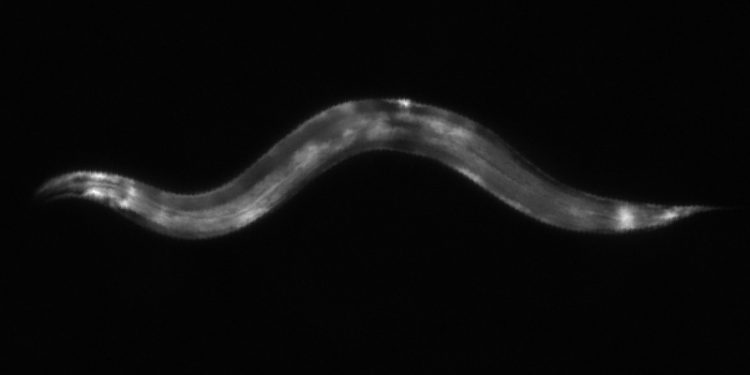Moderate Levels of ‘Free Radicals’ Found Beneficial to Healing Wounds

Increased levels of free radicals were found to speed the healing of wounds in the laboratory roundworm C. elegans. Credit: Suhong Xu, UC San Diego
That’s the conclusion of biologists at UC San Diego who discovered that “reactive oxygen species”—chemically reactive molecules containing oxygen, such as peroxides, commonly referred to as free radicals—are necessary for the proper healing of skin wounds in the laboratory roundworm C. elegans.
In a paper published in the October 13 issue of the journal Developmental Cell, the researchers found that free radicals generated in the mitochondria not only are necessary for skin wound healing, but that increased levels of reactive oxygen species, or ROS, can actually make wounds heal faster.
“There are many ways you can generate ROS in the cell, but no one had looked in the mitochondria in detail,” said Andrew Chisholm, a professor of biology at UC San Diego, who conducted the study with Suhong Xu, a postdoctoral fellow in his laboratory. “Our discovery was surprising because we didn’t realize that mitochondria were playing these roles in wound healing.”
Free radicals, or ROS, have long been known to damage DNA, RNA and proteins. Because such oxidative damage is thought to contribute to premature aging and cancer, many people take antioxidants to minimize the cellular damage from free radicals.
But the UC San Diego researchers found that while too much ROS in the cell may be bad for you, eliminating ROS altogether prevents wound healing, at least for roundworms. Their discovery has implications for the development of new pharmaceuticals to treat the elderly and people with diabetes who have chronic issues with wound healing.
“It appears you need some optimal level of ROS signaling,” explains Chisholm. “Too much is bad for you, but too little is also bad. We discovered in our experiments that when we knocked out the genes that produced ROS in the mitochondria and eliminated antioxidants, the roundworms had trouble closing up their wounds. We also found that a little more ROS helped the wounds close faster than normal.”
While the researchers have confirmed their results only for the lowly roundworm, they suspect it applies to higher animals and are planning to continue further investigations in rodents.
“We suspect that these genetic pathways are conserved, so that they would apply to vertebrates and mammals as well,” said Chisholm.
The project was supported by a grant from the National Institute of General Medical Sciences (NIGMS) of the National Institutes of Health (R01 GM054657).
Media Contact
All latest news from the category: Life Sciences and Chemistry
Articles and reports from the Life Sciences and chemistry area deal with applied and basic research into modern biology, chemistry and human medicine.
Valuable information can be found on a range of life sciences fields including bacteriology, biochemistry, bionics, bioinformatics, biophysics, biotechnology, genetics, geobotany, human biology, marine biology, microbiology, molecular biology, cellular biology, zoology, bioinorganic chemistry, microchemistry and environmental chemistry.
Newest articles

A universal framework for spatial biology
SpatialData is a freely accessible tool to unify and integrate data from different omics technologies accounting for spatial information, which can provide holistic insights into health and disease. Biological processes…

How complex biological processes arise
A $20 million grant from the U.S. National Science Foundation (NSF) will support the establishment and operation of the National Synthesis Center for Emergence in the Molecular and Cellular Sciences (NCEMS) at…

Airborne single-photon lidar system achieves high-resolution 3D imaging
Compact, low-power system opens doors for photon-efficient drone and satellite-based environmental monitoring and mapping. Researchers have developed a compact and lightweight single-photon airborne lidar system that can acquire high-resolution 3D…





















